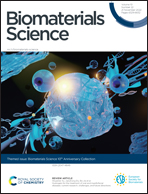Photo-crosslinkable methacrylated konjac glucomannan (KGMMA) hydrogels as a promising bioink for 3D bioprinting
Abstract
Three-dimensional (3D) bioink with favorable printability, strength, and biocompatibility challenged the 3D bioprinting technology in cartilage tissue engineering. Herein, we innovatively fabricated photo-crosslinkable methacrylated konjac glucomannan (KGMMA) as a novel biomaterial ink for 3D extrusion bioprinting in an attempt to construct precisely patterned tissues. Specifically, konjac glucomannan (KGM) was modified by methacrylic anhydride, which is a kind of photoreactive group, to form KGMMA. After UV crosslinking, the printed KGMMA hydrogel formed a covalent crosslinking network with high strength, desired shearing, and swelling and degradation characteristics. The properties of the KGMMA hydrogel could be modulated by changing the contents of MA. The shear-thinning property of the KGMMA biomaterial ink enables excellent printability, which can print different shapes including lattices, hexagons, and flowers. Furthermore, the bioinks support cell growth after being printed with chondrocytes for a culture. Therefore, the biodegradable, injectable, and photo-crosslinkable KGMMA biomaterial ink holds a great promise for cartilage tissue engineering.



 Please wait while we load your content...
Please wait while we load your content...